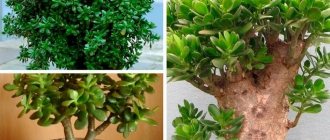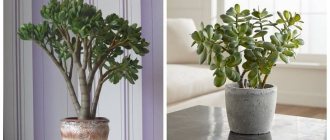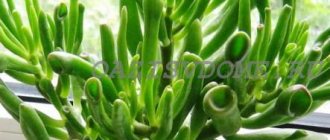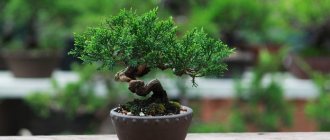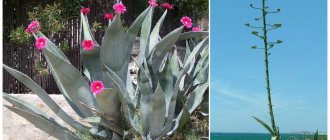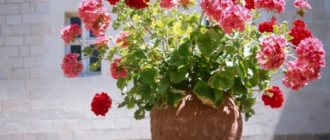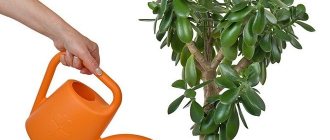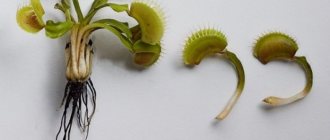The name "Money Tree" was introduced into use in China during the Han Empire (206 BC - 220 AD), which is confirmed by the finds of bronze and faience images during excavations of imperial tombs.
But the plant itself has been known to man since even earlier times, and South Africa is considered its homeland. Dear readers!
For you, we have created communities on social networks in which useful articles and interesting ideas are published several times a day! Subscribe and receive useful content in a convenient format! We are talking about a succulent from the genus Crassula or Crassula (the Tolstyankov family). In indoor floriculture, some types of this plant (K. tree-like, K. oval and others) are, indeed, more often called “Money tree” due to the round shape of the leaves.
Caring for the Money Tree after purchase
Crassula, like all succulents, can be easily grown from a cutting or leaf - they take root within a few days. If the plant was purchased in a flower salon, you need to remember some rules:
Important! The purchased “Money Tree” must undergo a period of acclimatization in the new room.
To carry out acclimatization, the pot is placed in its future place, slightly shading the bush, and left for two weeks. During this period, the plant is sprayed with warm water and the leaves are wiped, and watering is carried out only when it is very dry.- After the required time has passed, adult specimens, sitting in good soil and already adapted to the changed conditions, are left in place and provided with proper care.
- Half a month after purchase, young seedlings should be transplanted by transferring them into a more convenient pot (wide and shallow) with fresh soil. After the procedure, watering is prohibited for about 14 days, only spraying the top layer of soil. At the same time, the plant should be given partial shade. Further care is carried out as usual.
Growing conditions
In indoor culture, “Money Tree” will not cause much trouble. Like all plants that come from hot, dry parts of the planet, it will respond positively to sun, frequent changes in air masses, an adjusted watering schedule and a cool dormant period in winter. Even a beginner in floriculture who has studied its life cycle and basic requirements can grow a healthy specimen.
Temperature
The unpretentious Crassula can adapt to various room conditions, but the ideal temperature for it ranges between 18 and 25 degrees.
In this case, a contrast between day and night readings is absolutely necessary (within 5 - 10 degrees).
In the autumn season, when the plant begins to prepare for the dormant period, the temperature should be gradually lowered. In the winter months, the thermometer should show 10 - 15 degrees. And the condition of the tree must be constantly monitored - hypothermia must not be allowed.
If it is not possible to create winter coolness, then the “Money Tree” is placed far from heating devices and closer to the glass.
Air humidity and freshness
As a native of the arid zones of the earth, Crassula easily tolerates low humidity in apartment air.
On the contrary, it can be damaged by a humid microclimate - if such conditions arise, it is necessary to significantly reduce the amount of watering.
Spraying for the “Money Tree” should not be carried out (only to combat spider mites), but the leaves should be regularly wiped to remove dust.
In summer, the plant needs a constant change of air masses, so ventilation is very important, but drafts are unacceptable. It is allowed to take it out onto the balcony or veranda, protecting it from direct rays of the sun.
Illumination
Crassula is a light-loving plant, for which it is important to receive equally bright light all year round.
It can be in direct sunlight, but not for long, and if the leaves do not touch the window glass, otherwise burns are possible, which are characterized by a change in the color of the leaves to a red or brown tone.
With a lack of light, the bush loses its attractiveness. The leaves decrease in size, the branches become long and thin, sometimes taking on a drooping shape. The plant has a depressed, sickly appearance. But it can be called shade-tolerant, since the tree will withstand low light for a short time.
Reference! To preserve the decorative appearance of the crown and uniform all-round development of the branches, it is recommended to gradually rotate the “Money Tree” relative to the main light source.
Need for support
Sometimes the “Money Tree” stops growing evenly, it seems to fall on one side. To prevent the plant from falling, some kind of support is required. This state of affairs can arise for several reasons:
- Excessive watering , especially during the dormant period, does not allow the trunk to gain the necessary strength;
- The size of the pot does not match the size of the plant: the tree has grown, but the root system does not allow the small pot to develop. Requires transplantation;
- Incorrect formation of the crown leads to its weighting - the bush cannot support its own weight;
- Weakening due to overheating in the sun in summer.
To save the tree, it is necessary to find out and eliminate the cause. In the meantime, the plant will restore its shape, help it by providing support.
The best place for Crassula
As a plant that requires maximum light, the Money Tree thrives on sunny windowsills on the southeast side of the house.
With this location, the risk of burns from direct rays is eliminated. South-facing windows are also suitable, but they require shading in the summer.
The location of plants on the north or west side requires additional lighting, especially in winter.
How to root a Crassula with cuttings and leaves
It is best to propagate Crassula by rooting cuttings and leaves in the spring, when the plant begins to actively grow. As cuttings, it is best to take young shoots or extra branches of the plant, 10 cm long, with a strong trunk.
You need to cut them off with a sharp knife, sprinkling the wounds on the main plant with charcoal. The leaves of the plant can also be used for rooting. There are several ways to root Crassula with cuttings and leaves. Most often this is done in water, in prepared soil or on moss.
Rooting a money tree in water
In order to root a money tree with cuttings, you need to do the following:
- The cut cuttings should be left in the air, sprinkled with crushed charcoal on the wounds, for several hours so that they dry. After this, the cuttings need to remove the lower leaves to about half the height of the stems;
- Pour settled warm water into a clean glass or jar
- After this, the prepared cuttings must be lowered into water in a strictly vertical position, for which you can use cardboard circles with slots placed on the neck of the container;
- Glasses with cuttings are placed in a warm place, in partial shade.
The roots appear after about 2 weeks and immediately begin to develop rapidly. For this reason, cuttings should be planted in the ground immediately after the roots appear.
Rooting a fat plant in water with leaves is a little more difficult, since it is not easy to give them a strictly vertical position:
- You must also add a rooting agent solution to the water, then lower the leaves into it about 5 mm with the cut side down;
- Containers should be placed in partial shade, without access to direct sunlight;
- When the first roots appear, the leaves need to be carefully planted in small containers.
Often, when people try to root a crassula with leaves in water, they are faced with the fact that the leaves sprout crookedly, that is, the emerging sprout develops at an angle.
In this case, in order for the young plant to be smooth and beautiful, it is necessary to wait until the roots grow a little.
Then carefully cut off the mother leaf with a sharp knife so that only a small stump remains. In this form, the young sprout can be planted in the ground, giving it a level position.
Rooting Crassula in the ground
Germinating roots in water does not always give positive results, since the fat plant does not like large amounts of water. The use of this method can lead to rotting of the stem of the cuttings and the base of the leaves.
Therefore, many gardeners try to root the Crassula cuttings in the ground:
- To do this, cut cuttings must be sprinkled with charcoal and left in the air for a day to dry;
- Next, you need to pour soil into the germination container , leaving it loose, without compacting it;
- In the central part of the container, you need to use a stick to make a depression about 2 cm deep, into which the cutting is placed. It is best that the diameter of the stick and the handle be the same. There is no need to compact the soil around the trunk, just sprinkle it lightly with soil;
- After this, the soil in the pot must be carefully moistened with a sprayer, but this must be done so that the water does not get on the plant. The trunk and leaves of the cuttings must be dry.
Rooting in this case occurs within a couple of weeks, as evidenced by the appearance of new young leaves.
Rooting a fat plant with a leaf is performed according to the following scheme:
- Before planting, the leaf must be sprinkled with charcoal and left in the air for a day to dry;
- Next, you need to prepare a mixture of peat and coarse sand, put it in small flat containers, pour it with a rooting solution;
- Make small depressions in the ground and insert the leaves of the crassula into them at 2/3 of the height;
- The containers should be placed under a hood or in a greenhouse, ventilating them several times a day and spraying the leaves.
In such conditions, rooting will occur in approximately 3 to 4 weeks.
Rooting Crassula on moss
This method can be used to root Crassula with leaves only. To do this, you need to take a piece of moss from the forest; at home, it needs to be treated with a solution of potassium permanganate for disinfection. You can also buy moss at a flower shop.
The finished wet moss should be placed in a plastic box or glass, and then a money tree leaf should be inserted into it. There is no need to cover the container, but it is important not to forget to spray to maintain humidity. After the roots appear, the young sprout needs to be transplanted into the ground.
Crassula in the interior
A properly formed Crassula has the appearance of a small compact tree with a lignified brown trunk, the thickness of which depends on the age of the plant.
Adult specimens usually grow 1-1.5 m, but much taller plants are also found (up to 3 m).
After pinching, the branches grow greatly in width, forming a spreading crown with a large number of rounded leaves of a fleshy and plump texture. It is because of the shape of the leaf that the plant was dubbed the “Money Tree”.
The leaf color can be green or silver-blue. To form a beautiful crown, only one plant should grow in a pot.
It blooms very rarely in indoor culture. The first buds can form after 8 - 10 years of life . Small, star-shaped flowers are collected in small panicles. The color is white, pink or yellowish.
In the interior, the “Money Tree” looks very impressive - a smaller copy of huge trees involuntarily attracts the eyes of guests.
Flowering conditions
The flowering of the “Money Tree” directly depends on the growing conditions:
In the natural environment it blooms at the beginning of the growing season - in spring. Tiny stars of fragrant flowers with five petals form raceme- or panicle-shaped inflorescences. White and pink shades predominate.- In the natural environment, plants that have reached adulthood (8 - 15 years ) bloom, and at home this age is even more significant - around 20 years, subject to constant compliance with all the rules of care.
- Flowering in indoor culture occurs extremely rarely and not in every plant. Flowering period - winter months (very rarely - spring) . Inflorescences ripen on young shoots. The cooler the room, the longer the flowering (up to 3 months).
- In home culture, the “Money Tree” of the required age forms buds after long-term or short-term stress: stopping watering for a month or a sharp change in temperature. A return to normal conditions may result in flowering. But you can also destroy the plant (by drying it or freezing it).
- After the first domestic flowering, this process can be repeated annually, but five-year intervals are also possible.
Types and varieties
There are about 300 species of Crassula in nature. Only a few of them are suitable for growing at home.
Crassula perforata (perforate)
This plant is distinguished from other species by the unusual arrangement of diamond-shaped leaves, which seem to be strung on erect stems. The color of the leaf blades is also interesting - green with a bluish tint in the middle and red at the tip.
Good lighting is very important for this type of Crassula. In the shade, the color of the leaves will be less bright, which will significantly affect the overall decorativeness of the plant.
Crassula Nealiana
A succulent with drooping, densely leafy shoots, the average length of which is 15 cm. The leaves are dense, silvery. During the flowering period, as can be seen in the photo, Crassula is covered with small buds located on the tops of the shoots. In good light, the leaves take on a reddish tint.
Crassula nile
A low indoor plant with dense, erect shoots and small triangular leaves, which in appearance resembles Nealiana. The leaf color is green with a red edge. Like Crassula perforatum, the leaves seem to be strung on the stem.
Crassula Marnier
The erect stems of this plant bend under the weight of fleshy, leathery leaves as they grow. The color of the leaf blades is green-blue. The flowers are white, small, no more than 4 mm in diameter.
Transfer
The money tree has a negative attitude towards procedures such as transplantation. Therefore, this activity is carried out only in cases of extreme necessity and with extreme caution.
Young seedlings should be replanted regularly in the spring, as they grow quickly and require a larger pot. Purchased plants should also be replanted in order to improve the soil and container, but only after a period of acclimatization in the new place (2 weeks). Adult trees are subjected to this procedure as they grow, but not more often than after 3 years.- Transplantation is carried out at the beginning of the growing season, that is, in the spring. Due to the strong fragility of the branches and the weak, fragile root system, the procedure is carried out using transfer methods: the plant is carefully removed from the old pot and, together with a lump of earth on the roots, is transferred to a new container, then fresh soil is added and slightly compacted around the edges.
- To better adapt the tree to the new soil, you should not deepen the trunk too much - the surface of the earth should remain at the same level so that the root collar is not damaged.
- Since the soil gradually deteriorates, it must be completely changed periodically. To do this, the roots are carefully cleared of soil, inspected and cut if necessary (all cuts are treated with activated carbon) and placed in a new substrate. After transplanting, water and place in a cool place for a week or two.
Attention! “ Money tree” is characterized by a weak root system that does not correspond to the volumetric crown. Therefore, when replanting, it is necessary to choose a wide, weighty pot with a stable bottom and fill it with heavy drainage pebbles. This will prevent the plant from tipping over and breaking.
Landing
If you want to grow a “Money Tree” yourself, you can use two planting methods:
Planting a plant with seeds. Use small, wide pots with good drainage holes. Seeds are placed in them, lightly sprinkled with soil, and a kind of greenhouse is created using a transparent vessel. Seeds require daily ventilation and soil moisture. In just half a month, sprouts may appear.- Planting by cuttings. A branch is cut from an adult plant and placed in water. After the roots have formed, the cuttings can be planted in cactus soil or regular soil. The cuttings will take root when planted immediately in the ground.
How to propagate Crassula by seeds
Typically, this method of plant propagation is used by breeders who want to develop new varieties of Crassula, since the technique requires a lot of patience and takes a lot of time.
Seed material is collected from plants after the flowers have faded.
To sow seeds, you need to prepare containers and fill them with a mixture of coarse sand (1/2 part) and leaf soil (1 part). The soil surface is leveled, slightly moistened with a sprayer, after which the seeds are laid out and sprinkled with a thin layer of clean river sand.
The surface is once again sprayed with water from the sprayer, after which the containers must be covered with clean glass.
Every day the crops must be ventilated by lifting the glass. The seeds will begin to hatch in about 4 weeks. As soon as young sprouts appear, they must be planted in separate containers with nutritious soil for succulents and placed in a bright place.
Reproduction
"Money Tree! most often propagated by cuttings - leaves or stems. The operation is performed in the spring, but if you have a strong desire to grow a talisman, you can take cuttings at other times of the year. Use the apical shoots and lightly dry them (2 days). The finished material is planted in loose soil and periodically moistened. Rooting takes about three months.
A faster way is to root the cuttings in water and then plant them in a timely manner. In this option, roots form earlier, especially in bright light.
Sometimes broken leaves take root on the ground on their own. Then all that remains is to transplant them.
Seed propagation is used much less frequently. It involves the use of a greenhouse and double picking of seedlings. Sprouts appear after 10 – 14 days.
Methods of propagation and rooting
When the fat plant is cared for correctly, lightening and shaping pruning is done regularly. The remaining material can be used for vegetative propagation of the money tree.
The method is much simpler than the seed method and allows you to preserve varietal characteristics. In spring or early summer, almost all leaves and cuttings take root. Before or during the dormant period, growth processes slow down and rooting goes poorly.
Vegetative propagation
The branches of the crassula remaining after formation or specially cut ones are dried for at least a day in a warm, well-ventilated room. Then they are placed in water or placed in small individual cups with bottom holes. As a substrate you can use:
- soil for cacti with sand (1:1);
- perlite
The leaves are taken from the middle of the crown of the crassula; they are mature, but not old. It is better to plant them - the plates often rot in water. You can dry it until the turgor is completely lost; experienced cactus growers keep the leaves in the fresh air and warm until they take root.
A peculiarity of the Crassula is that the formation of lower shoots in the substrate proceeds well only in withered vegetative organs. As long as there is moisture in them, the plant does not see the need to release roots.
This is what causes care. During germination of Crassula leaves and cuttings, you must not:
- spray;
- cover with glass or film.
The surface of the substrate should only be carefully watered so that the tender young roots of the fat plant do not dry out. The rest of the care consists of maintaining warmth and moderate lighting. In the shade, in bright sun or at low temperatures, reproduction is likely to fail.
Having produced a new pair of leaves, the cuttings are gradually accustomed to intense lighting and cared for as if they were an adult Crassula. The daughter rosettes formed next to the plate are grown, then separated and planted in individual containers, possibly with the mother leaf.
Propagation by seeds
If the crassula blooms at home, even with good care the seeds do not ripen, you need to buy them. This method of breeding is interesting for breeders; for hobbyists it makes sense if a species or variety cannot be obtained in any other way.
Sowing is done to a depth of 5 mm, kept at high temperature and humidity under glass or film. After the emergence of seedlings, they are accustomed to light and fresh air. Before planting in a permanent pot, they dive twice.
Even if you care for the seedlings carefully, the sprouts may die at any stage of cultivation. This difficult activity is not for beginners; if possible, it is better to avoid it.
Crown formation
To give the Crassula the shape of a tree, it is necessary to form a crown. This is a very responsible and lengthy process that allows you to achieve the decorative appearance of the “Money Tree”. An exception to this is T. arborescens, which itself forms its own tree contour.
You need to start creating a crown from the beginning of plant growth. At the first stage, all side branches are removed until the bush grows to the desired height. The condition of the first step is that half of the trunk must be bare.- The second stage of tree formation can be considered pinching the top growth point. At the same time, lateral buds wake up, shoots from which will become the basis of the crown. During this period, it is necessary to begin turning the plant relative to the light, otherwise the crown will turn out to be one-sided.
- Next, the crown contour is created. After the formation of the fourth pair of leaves, the upper buds of all side shoots are removed for greater branching. The longest branches are pruned to prevent weakening and shading. The sections tighten themselves, but ideally it is advisable to carry out the formation only by pinching. Direct the branches upward.
- If it is necessary to remove an already formed adult branch, the cut is treated with activated carbon. This pruning is needed to free up the middle part of the crown.
- It is necessary to constantly form the crown as the “Money Tree” grows. Pruning is done above the brown rings on the trunk (leaf scar). The tree tolerates all measures to create a crown calmly and grows even more actively. But the plant should rest between prunings.
- The condition for obtaining a beautiful tree shape is the presence of only one seedling or cutting in the pot.
- To give the trunk thickness, all young shoots are pinched.
Watering mode
In the warm season, Crassula requires regular, but very moderate watering. The soil in the pot should dry out at least half between waterings. Excessive moisture threatens rotting of the root system and possible death of the plant. Therefore, the flowerpot should be kept in a tray and excess liquid should be drained.
Water for irrigation is taken that is settled and warm.
Peculiarity! The “money tree” can go without watering for quite a long time - it is more afraid of waterlogging than drying out.
When providing the “Money Tree” with a winter dormant period, watering is canceled, since the plant has enough moisture accumulated in the leaves. If the soil is very dry, it can only be slightly moistened (once every two weeks) to prevent the roots from drying out.
When kept warm in winter, watering is carried out according to the summer principle - depending on temperatures and drying of the soil (twice a week).
The plant does not need to be sprayed either in summer or winter. But wiping the leaves from dust with a damp sponge is useful.
Top dressing
At home, the “Money Tree” grows in soils that are not very rich in nutrients.
Therefore, it does not like frequent feeding. During the growing season, it is enough to fertilize the soil once a month. During cold wintering, reduce the use of fertilizing.
The main rules of feeding:
- Apply fertilizer after watering to protect the roots from burns;
- Fertilizer should not be used on transplanted and diseased specimens - this can lead to the death of the plant.
To feed the Money Tree, use standard fertilizers for cacti or alternate between regular mineral fertilizers and organic matter.
Home care
In order for the plant to grow well and actively increase the vegetative mass, you need to know how to water the flower and feed it correctly.
Temperature
The money tree is characterized as an unpretentious plant that can grow and develop in any degree of lighting.
However, a lack of sunlight can lead to elongation of the stems and a decrease in their foliage, which will not have the best effect on the decorative appearance of the Crassula. Therefore, it is better to choose a well-lit place for it.
By the way, experienced flower growers recommend taking Crassula outdoors throughout the summer, especially since a slight drop in temperature at night will benefit this plant.
Watering
Crassula is a drought-resistant plant that tolerates a lack of water in the soil better than excess. Moreover, stagnation of moisture in the pot can cause the death of the succulent.
In the hot summer, Crassula is watered as the top layer of soil dries, and in winter the soil is moistened only after it has dried deeply. This is approximately once a week.
Advice! The fleshy leaves of the fat plant are able to absorb moisture from the air, so the plant will probably enjoy procedures such as regular spraying with warm water and showering.
Top dressing
Home care will not be complete without regular feeding of the plant. Crassula is fed during the period of active growth, which occurs in spring and summer. In the spring this is done once a month, and in the summer - once every 1.5 months.
As a fertilizer, you can use ready-made mineral complexes for ornamental plants or organic fertilizers prepared from available raw materials (onion and potato peels, green grass).
In winter, when the plant is dormant, it is not fed.
Trimming
Another aspect of indoor care is pruning Crassula, which can be:
- sanitary, which involves the removal of diseased and damaged parts of the plant;
- formative, the purpose of which is to improve the decorative effect of the succulent.
It is better to form the crassula crown in the first year of the plant’s life, when its shoots are still quite thin. At a later age, unsightly stumps may remain at the site of the cuts.
Diseases and pests
"Money tree" is quite resistant to diseases and pests.
All diseases that can still affect a plant arise from non-compliance with the rules of care:
- Various rot - violation of the watering schedule;
- Falling leaves - too much watering of the Money Tree or overheating during winter dormancy;
- Wrinkled leaves - when the roots dry out or there is little light;
- Spots of light shades on the leaves are burns from the sun's rays.
Pests rarely attack the Money Tree due to the arsenic contained in the leaves. In addition, a healthy plant itself can cope with parasites. If kept improperly, spider mites, scale insects, aphids and mealybugs may appear. To eliminate them, treatment with acaricides or insecticides is required.
How to resuscitate?
The peculiarities of the “Money Tree” as a succulent plant make it possible to avoid the death of damaged specimens.
When shedding leaves, loss of turgor, stretching of branches and other problems associated with improper care, it is enough to remove the damaged areas.
It is necessary to create comfortable conditions for the plant to return to its original appearance.
But when root rot is discovered on the Money Tree, drastic measures are required to resuscitate it. Infected roots are removed from the plant, treated with an antiseptic and replanted in new soil. If all the roots are dead, then the top of the tree is cut off and rooted, as with cuttings. This is the only way to save the plant.
The most common mistakes when growing
“Money tree” is very unpretentious and does not require much time to care for. But due to inexperience, beginners sometimes have problems and they have to overcome the consequences of their mistakes:
- Refusal to form a contour or create a one-sided crown (do not turn the plant relative to the light) - this can lead to the bush turning over due to the heavy crown.
- Too frequent watering leads to the formation of root rot, leaf fall and even tree death.
- Incorrect location in the room - lack of light threatens to stretch branches, crush leaves and loss of decorativeness; Direct rays of the sun depress the plant due to overheating and burn the leaves.
- Insufficient soil moisture leads to drying out of the root system.
- Feeding without prior watering will cause burns on the roots.
- Feeding a sick or transplanted plant means oversaturation with nutrients, pain and loss of appearance.
- Transplanting the “Money Tree” immediately after purchase – the plant does not adapt and slows down its growth and development.
Reasons why the money tree does not bloom
Many indoor plant lovers who have a Crassula plant do not know whether the money tree is blooming. If so, how does it bloom, how to make the plant form buds.
Theoretically, the money tree blooms after three years of age. In order for it to form buds, it is necessary to constantly monitor the growing conditions. The flowers of the money tree look like white stars and emit a sweetish aroma. The process lasts 2 – 2.5 months.
To prevent the plant from wasting energy on producing seeds, the fading buds are cut off. If several representatives of this species, Crassula mix, grow in a house, then they bloom simultaneously, with flowers of different shapes and sizes.
Why is there no flowering in an adult Crassula:
- insufficient watering, therefore, poor absorption of nutrients;
- lack of light, poor chlorophyll formation;
- the plant has not been replanted for a long time, low humus content in the soil;
- lack of fresh air;
- drafts;
- lack of fertilizing.
To correct the situation, it is necessary to analyze all the conditions that lead to the setting of buds and create them in a money tree.
Answers to popular questions
When will the Money Tree bloom?
Only mature trees are ready for flowering - this can happen in 10 - 20 years. In addition, to produce flowers, the plant needs a period of winter dormancy, and sometimes a little stress in the form of drought or shade. And not all Crassulas bloom in indoor culture.
How long does a tree live?
Under natural conditions, the plant lives for decades and reaches considerable sizes. In an apartment, the “Money Tree” depends entirely on the care and love of the grower - in comfortable conditions it can be passed on through several generations.
The tree is withering. Why and what to do?
It is quite obvious that the plant was watered too often, and the root system died from waterlogging. It is necessary to make cuttings from a healthy part of the crown and grow new trees. Be sure to adjust their watering schedule.
The Money Tree is said to be poisonous. Is it true?
Indeed, in nature, Crassula can accumulate a sufficient amount of arsenic in its leaves. But a cultivated tree does not have this opportunity, since the soil in which it grows does not contain this poison. The plant is safe for children and animals.
Carefully! You should not ingest the leaves of the wild-growing “Money tree” - they contain poison.
Does the tree have medicinal properties?
Even in ancient China, the leaves of the Money Tree were used to treat abscesses, wounds and insect bites - the plant has anti-inflammatory properties. It can cure a sore throat, it helps with kidney diseases.
In addition, the tree has a strong connection with the owners of the house: if a family member gets sick, the plant droops and loses its outer shine. When a person recovers, the plant soon also returns to its decorative properties.
I need to go on a business trip for a month. How to leave a tree?
There is a rule regarding watering the Money Tree: it is better to dry it out than to overwater it. Before leaving, the plant should be watered, the soil should be mulched and the pot should be placed away from the window. In this state it will feel great all month.
Why can't I form a round crown?
You need to form the crown gradually, pinching out the branches that stand out. To prevent the crown from being one-sided, the plant must be rotated from time to time relative to the light source. All branches will receive the same lighting and will begin to develop synchronously.
Timing for transplanting a money tree
Crassula reacts extremely negatively to all interference in her living space, so you need to disturb her as little as possible, choosing the most appropriate time. The money tree is not at all picky and capricious in its daily care, but it is very sensitive to replanting. It is best to do this in early spring, as soon as active growing season begins. The fat plant will survive the summer relocation, but in the autumn-winter period this is only possible in emergency situations, when the bush is clearly sick and there is no way to wait.
